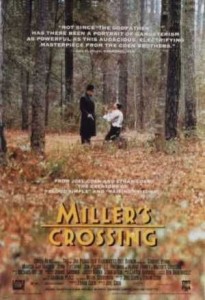 Miller’s Crossing (1990) *** Burke Favorite
Miller’s Crossing (1990) *** Burke Favorite
Dir: The Coen Brothers
Stars: Gabriel Bryne, Albert Finney, Marcia Gay Harden and John Turturro
Just in time for St. Patrick’s Day! Can you think of any other St. Patty’s Day-worthy films, aside from perhaps Darby O’Gill and The Little People? [My apologies, folks, but I’m not really available to provide a review on that little gem Darby just now…] And besides, Miller’s Crossing is appropriate for this holiday because of its themes. It focus on a group of Irish gangsters, led by Albert Finney’s Leo, who’re being muscled in on by a group of Italians (Jon Polito & Co.). The story is reminiscent of Kurosawa’s Yojimbo and even Last Man Standing, both of which are loosely based upon Dashiell Hammet’s novel, Red Harvest. Regardless, the story construct is basically this: each of the gangs, the Irish and the Italian, is sure it’s the best in town. In the process of fighting each other, they’re tearing the town apart until one man – in this case, Gabriel Bryne’s Tom Reagan – manipulates both gangs till he himself actually rules the town. I’m not saying that’s the end of Miller’s Crossing, just trying to offer a context of the story.
Regardless, this qualifies as a film with “Burke Favorite” attached to it for several reasons – it has “THE” scene, some phenomenal, quotable dialogue and an entertaining motif. I’m not going to touch on story specifics, like John Turturro’s Bernie Birnbaum or Steve Buscemi’s cameo as Mink Larue. Instead, we’ll touch on these three elements to this deeply satisfying action-drama.
“THE” SCENE
Every good film, and I do mean every one of them, has that one phenomenal scene. That scene that makes the whole film worth another watch. Some great films have three or four “can’t miss” scenes. You know the kind I mean, when you’re sitting on your couch after a run on Saturday afternoon and the chase scene involving a Police horse from True Lies comes on. Looks like you’ll be late to the dinner party. Check the AFI top 100, for example and see if I’m lying here – every great film has at least one incredible scene.
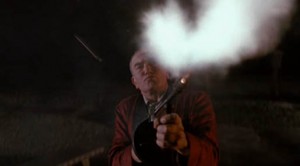 Miller’s Crossing is no exception. In this scene, the first shot is of Irish Boss Leo, played by Albert Finney. He’s enjoying a cigar, the evening paper and a listen of the Irish classic Danny Boy on a record player as he lounges in bed, already dressed in his comfortable pajamas. The next shot is of a dead man’s blood spilling all over the floor in the living room downstairs. In the foreground, the dead man’s cigarette lights his newspaper on fire. Ruh roh… In the background of the shot, two pairs of slacks with Tommy Guns aside them stroll up the stairs. The next shot is of Leo, taking a nice puff of his cigar and then softly removing this reading glasses… his face seems to say, “Is that SMOKE that I see emerging from the floor boards?” Next shot is a closer perspective of the slacks and machine guns climbing the stairs. Then, we see Leo put his feet in some slippers, put out his cigar and lay his hand on a revolver.
Miller’s Crossing is no exception. In this scene, the first shot is of Irish Boss Leo, played by Albert Finney. He’s enjoying a cigar, the evening paper and a listen of the Irish classic Danny Boy on a record player as he lounges in bed, already dressed in his comfortable pajamas. The next shot is of a dead man’s blood spilling all over the floor in the living room downstairs. In the foreground, the dead man’s cigarette lights his newspaper on fire. Ruh roh… In the background of the shot, two pairs of slacks with Tommy Guns aside them stroll up the stairs. The next shot is of Leo, taking a nice puff of his cigar and then softly removing this reading glasses… his face seems to say, “Is that SMOKE that I see emerging from the floor boards?” Next shot is a closer perspective of the slacks and machine guns climbing the stairs. Then, we see Leo put his feet in some slippers, put out his cigar and lay his hand on a revolver.
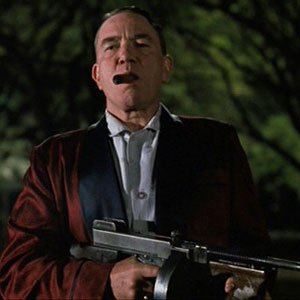 I’ll leave it to you to enjoy the rest of that scene, either for the first time or the latest in several viewings. However, I hope the point is clear – the Coen Brothers are as visually adept at building tension as Hitchcock…. They seem to have a different sense of humor as you’ll see in how this scene plays out, but they deserve credit for telling compelling stories with pictures, not talking heads. Actually, I guess they tell great stories using both techniques, don’t they? Let me finish “THE Scene” by saying that this montage involving Leo and his assassins is really one of several great ones in Crossing – but let’s consider the Coen Brothers’ talents at dialogue for a moment…
I’ll leave it to you to enjoy the rest of that scene, either for the first time or the latest in several viewings. However, I hope the point is clear – the Coen Brothers are as visually adept at building tension as Hitchcock…. They seem to have a different sense of humor as you’ll see in how this scene plays out, but they deserve credit for telling compelling stories with pictures, not talking heads. Actually, I guess they tell great stories using both techniques, don’t they? Let me finish “THE Scene” by saying that this montage involving Leo and his assassins is really one of several great ones in Crossing – but let’s consider the Coen Brothers’ talents at dialogue for a moment…
DIALOGUE
I’m just going to insert some favorites here to give you the flavor of the character’s speech. When I think of some top films with great dialogue that aren’t written by Quentin Tarantino, I think of this, old Sam Spade pictures, several David Mamet titles and Michael Mann’s Heat. My reference for this section is a copy of the script that I found on <Dailyscript.com> It’s a great site to look up scripts for your reading pleasure, or to find little snippets, like you’ll see below:
Tom stops in Verna’s apartment for a drink –
TOM: I was in the neighborhood, feeling a little daffy. Thought I’d drop in for an aperitif.(pause). Rug Daniels is dead.
VERNA: Gee, that’s tough.
TOM: Don’t get hysterical. I’ve had enough excitement for one night without a dame going all weepy on me.
VERNA: I barely knew the gentleman.
TOM: Rug? Bit of a shakedown artist. Not above the occasional grift, but you’d understand that. All in all, not a bad guy if looks, brains and personality don’t count.
VERNA: You’d better hope they don’t.
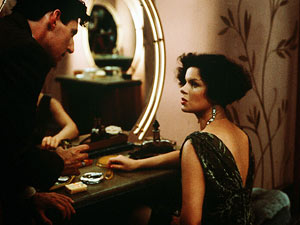 Tom, with a nasty hangover, bangs on Verna’s door. She opens.
Tom, with a nasty hangover, bangs on Verna’s door. She opens.
TOM: I want my hat.
VERNA: I won it. It’s mine.
TOM: What’re you going do with it?
VERNA: Drop dead.
Pause as Tom gets the door slammed in his face, knocks and Verna opens it again.
TOM: I need a drink.
VERNA: Why didn’t you say so?
She opens the door wide for him to enter.
Johnny Caspar (the Italian’s lead gangster) talks to Tom about whether or not his henchman, The Dane, is selling him out:
CASPAR: I’ll admit, since last we jawed, my stomach’s been seazin’ up on me. The Dane saying we should double-cross you; you double-cross once, where’s it all end? An innaresting ethical question.
These lines aren’t there for show – they all mean something to the character that’s saying them. Take Johnny Caspar’s ongoing reference to the “high hat.” Johnny’s a little insecure, he’s balding, he’s a little heavy and he hates people thinking he’s NOT the number one villain in town. So when, in the first scene, he asks Leo for a favor and Leo denies him, Caspar explodes –
CASPAR: I pay off to you every month like a greengrocer–a lot more than the Motzah–and I’m sick a gettin’ the high hat–
LEO: You pay off for protection, just like everyone else. Far as I know–and what I don’t know in this town ain’t worth knowing–the cops haven’t closed any of your dives and the D.A. hasn’t touched any of your rackets. You haven’t bought any license to kill bookies and today I ain’t selling any. Now take your flunky and dangle.
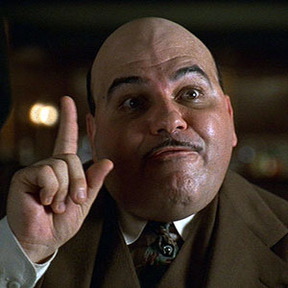 Caspar SLAMS the desk and steps close into frame.
Caspar SLAMS the desk and steps close into frame.
CASPAR: You think I’m some guinea fresh off the boat and you think you can kick me. But I’m too big for that now. I’m sick-of takin’ the strap from you, Leo. I’m sick a marchin’ down to this goddamn office to kiss your Irish ass. And I’M SICK A THE HIGH HAT!
The high hat, folks. The high hat. Don’t give it to Johnny Caspar.
MOTIF
That damned HAT – and I mean Tom’s fedora, this time. It’s in the dream in the beginning… would you agree that it’s Tom’s soul? Let me go a little slower.
First off, what the hell’s a “motif?” It’s basically that recurring image or sequence of images that help define a character over the course of a film. One of my favorite examples is Russell Crowe’s Maximus in Gladiator: if you notice, before every battle Maximus gets into – whether it’s on a field or in the arena – he picks some dirt up off the ground and rubs it in his hands as if to say, “I’m ready to get messy, here.”
While there are plenty of other examples, in Miller’s Crossing, Tom’s hat is the motif. It’s there in his dream during the credits, which he references to Verna later in the story after a little bed play. He MUST get it back when he wakes up totally hungover (see the dialogue reference above). Leo tosses it onto Tom’s chest after he beats the snot out of him to make sure everyone knows “we’re quits.” And it’s there in the very last bloody frame of the film! Watch that last frame, how carefully Tom applies the hat to his head…
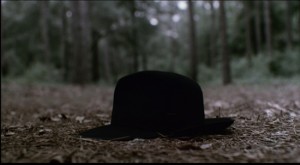 What I’m implying is that the story concerns Tom trying to do his best for his pal and boss, Leo, but without losing himself (or his HAT) in the process. There are several instances when it looks like Tom might lose his hat. While the dream sequence is more figurative, the scene in which The Dane takes Tom back out to Miller’s Crossing and tosses his hat off his head before he pulls the gun on him kind of supports what I’m saying. It’s as if The Dane is visually alerting us, “I’m about to kill this guy – see, I can do whatever I want with his hat!” I don’t know… I’ve watched this film a LOT, so please pardon my thoughts and ramblings here: but to briefly summarize, my thinking is that Tom’s soul, his ethics, his very person is visually defined by his hat.
What I’m implying is that the story concerns Tom trying to do his best for his pal and boss, Leo, but without losing himself (or his HAT) in the process. There are several instances when it looks like Tom might lose his hat. While the dream sequence is more figurative, the scene in which The Dane takes Tom back out to Miller’s Crossing and tosses his hat off his head before he pulls the gun on him kind of supports what I’m saying. It’s as if The Dane is visually alerting us, “I’m about to kill this guy – see, I can do whatever I want with his hat!” I don’t know… I’ve watched this film a LOT, so please pardon my thoughts and ramblings here: but to briefly summarize, my thinking is that Tom’s soul, his ethics, his very person is visually defined by his hat.
Long and short, what a great film to celebrate the genuine themes of St. Paddy’s Day, which I’ll let Johnny Caspar elaborate on for me:
CASPAR: I’m talkin’ about friendship. I’m talkin’ about character. I’m talkin’ about–hell, Leo, I ain’t embarassed to use the word–I’m talkin’ about ethics.
